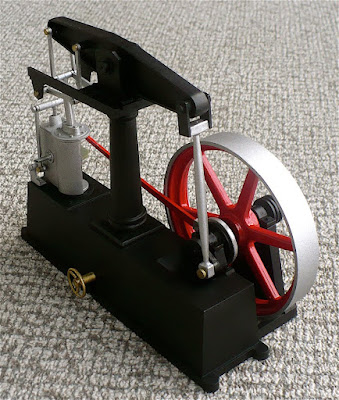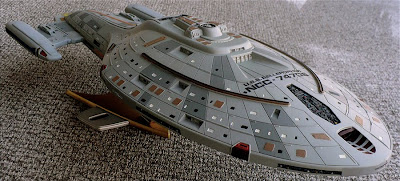



 Here are some more images of Trumpeter Models 1/32 scale North American RAF Mustang III.From Wikipedia"
Here are some more images of Trumpeter Models 1/32 scale North American RAF Mustang III.From Wikipedia"In April 1942, the RAF's Air Fighting Development Unit (AFDU) tested the Mustang and found its performance inadequate at higher altitudes. As such, it was to be used to replace the Tomahawk in Army Cooperation Command squadrons, but the commanding officer was so impressed with its maneuverability and low-altitude speeds that he invited Ronnie Harker from Rolls-Royce's Flight Test establishment to fly it. Rolls-Royce engineers rapidly realized that equipping the Mustang with a Merlin 61 engine with its two-speed two-stage supercharger would substantially improve performance and started converting five aircraft as the Mustang Mk X. Apart from the engine installation, which utilized custom-built engine bearers designed by Rolls-Royce and a standard 10 ft 9 in (3.28 m) diameter, four-bladed Rotol propeller from a Spitfire Mk IX, the Mustang Mk X was a straightforward adaptation of the Mustang Mk I airframe, keeping the same radiator duct design. The Vice-Chief of the Air Staff, Air Marshal Sir Wilfrid R. Freeman, lobbied vociferously for Merlin-powered Mustangs, insisting two of the five experimental Mustang Mk Xs be handed over to Carl Spaatz for trials and evaluation by the U.S. 8th Air Force in Britain. The high-altitude performance improvement was remarkable: the Mustang Mk X (serial number AM208) reached 433 mph (697 km/h) at 22,000 ft (6,700 m), and AL975 tested at an absolute ceiling of 40,600 ft (12,400 m).
Two XP-51B prototypeswere adapted from P-51 airframes; these were a more thorough conversion than the Mustang X, with a tailor-made engine installation and a complete redesign of the radiator duct. The airframe itself was strengthened, with the fuselage and engine mount area receiving more formers because of the greater weight of the Packard V-1650-3, 1,690 lb (770 kg), compared with the Allison V-1710's 1,335 lb (606 kg). The engine cowling was completely redesigned to house the Packard Merlin, which, because of the intercooler radiator mounted on the supercharger casing, was 5 in (130 mm) taller and used an updraught induction system, rather than the downdraught carburetor of the Allison. The new engine drove a four-bladed 11 ft 2 in (3.40 m) diameter Hamilton Standard propeller that featured cuffs of hard molded rubber. To cater for the increased cooling requirements of the Merlin a new fuselage duct was designed. This housed a larger radiator, which incorporated a section for the supercharger coolant, and, forward of this and slightly lower, an oil cooler was housed in a secondary duct which drew air through the main opening and exhausted via a separate exit flap.[
It was decided that the armament of the new P-51B (NA-102) would permanently omit the previously nose-mounted machine guns used on earlier P-51 versions, and only the four wing-mounted .50 in (12.7 mm) M2/AN Browning machine guns (with 350 rpg for the inboard guns and 280 rpg for the outboard) of the P-51A would be used for its gun armament. The bomb rack/external drop tank installation, adapted from the A-36 Apache attack version, would also be used; the racks were rated to be able to carry up to 500 lb (230 kg) of ordnance and were also capable of carrying drop tanks. The weapons were aimed using an N-3B optical gunsight fitted with an A-1 head assembly which allowed it to be used as a gun or bomb sight through varying the angle of the reflector glass. Pilots were also given the option of having ring and bead sights mounted on the top engine cowling formers. This option was discontinued with the later P-51Ds.
The first XP-51B flew on 30 November 1942. Although flight tests confirmed the potential of the new fighter, with the service ceiling being raised by 10,000 feet and the top speed improving by 50 mph at 30,000 ft (9,100 m), it was soon discovered that the radiator duct airflow was breaking up at high speeds, generating a rumble as the exit shutter was closed. Testing at the Ames Aeronautical laboratory led to a redesign of the radiator scoop culminating in a forward slanted upper lip. After sustained lobbying at the highest level, American production was started in early 1943 with the P-51B (NA-102) being manufactured at Inglewood, California, and the P-51C (NA-103) at a new plant in Dallas, Texas, which was in operation by summer 1943. The RAF named these models Mustang Mk III. In performance tests, the P-51B reached 441 mph (709.70 km/h) at 30,000 ft (9,100 m). In addition, the extended range made possible by the use of drop tanks enabled the Merlin-powered Mustang to be introduced as a bomber escort with a combat radius of 750 miles using two 75 gal tanks.
The range would be further increased with the introduction of an 85 gal (322 l) self-sealing fuel tank aft of the pilot's seat, starting with the P-51B-5-NA series. When this tank was full, the center of gravity of the Mustang was moved dangerously close to the aft limit. As a result, maneuvers were restricted until the tank was down to about 25 U.S. gal (95 l) and the external tanks had been dropped. Problems with high-speed "porpoising" of the P-51Bs and P-51Cs with the fuselage tanks would lead to the replacement of the fabric-covered elevators with metal-covered surfaces and a reduction of the tailplane incidence. With the fuselage and wing tanks, plus two 75 gal drop tanks, the combat radius was now 880 miles.
Despite these modifications, the P-51Bs and P-51Cs, and the newer P-51Ds and P-51Ks, experienced low-speed handling problems that could result in an involuntary "snap-roll" under certain conditions of air speed, angle of attack, gross weight, and center of gravity. Several crash reports tell of P-51Bs and P-51Cs crashing because horizontal stabilizers were torn off during maneuvering. As a result of these problems, a modification kit consisting of a dorsal fin was manufactured. One report stated:
"Unless a dorsal fin is installed on the P-51B, P-51C and P-51D airplanes, a snap roll may result when attempting a slow roll. The horizontal stabilizer will not withstand the effects of a snap roll. To prevent recurrence, the stabilizer should be reinforced in accordance with T.O. 01-60J-18 dated 8 April 1944 and a dorsal fin should be installed. Dorsal fin kits are being made available to overseas activities"
The dorsal fin kits became available in August 1944, and were fitted to P-51Bs and P-51Cs, and to P-51Ds and P-51Ks. Also incorporated was a change to the rudder trim tabs, which would help prevent the pilot over-controlling the aircraft and creating heavy loads on the tail unit.
One of the few remaining complaints with the Merlin-powered aircraft was a poor rearward view. The canopy structure, which was the same as the Allison-engined Mustangs, was made up of flat, framed panels; the pilot gained access, or exited the cockpit by lowering the port side panel and raising the top panel to the right. The canopy could not be opened in flight and tall pilots especially, were hampered by limited headroom. In order to at least partially improve the view from the Mustang, the British had field-modified some Mustangs with clear, sliding canopies called Malcolm hoods (designed by Robert Malcolm). The new structure was a frameless plexiglas moulding which ballooned outwards at the top and sides, increasing the headroom and allowing increased visibility to the sides and rear. Because the new structure slid backwards on runners it could be slid open in flight. The aerial mast behind the canopy was replaced by a "whip" aerial which was mounted further aft and offset to the right. Most British Mk IIIs were equipped with Malcolm hoods. Several American service groups "acquired" the necessary conversion kits and some American P-51B/P-51Cs appeared with the new canopy, although the majority continued to use the original framed canopies.
P-51Bs and P-51Cs started to arrive in England in August and October 1943. The P-51B/P-51C versions were sent to 15 fighter groups that were part of the 8th and 9th Air Forces in England and the 12th and 15th in Italy (the southern part of Italy was under Allied control by late 1943). Other deployments included the China Burma India Theater (CBI).
Allied strategists quickly exploited the long-range fighter as a bomber escort. It was largely due to the P-51 that daylight bombing raids deep into German territory became possible without prohibitive bomber losses in late 1943.
A number of the P-51B and P-51C aircraft were fitted for photo reconnaissance and designated F-6C.



















































